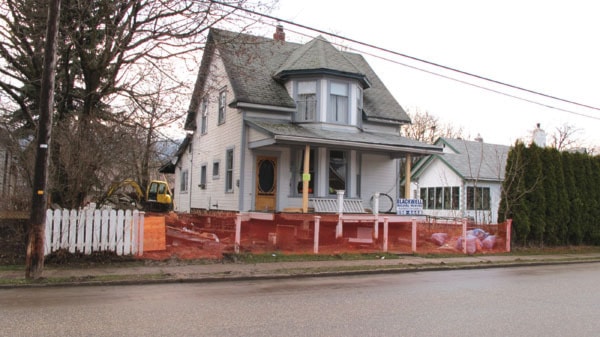When couple Susan Stokes and Rick Browning found a gem of a house at 171 First St. SE, they thought they’d discovered a perfect home. It was a place to raise children. It had three bedrooms, a nice backyard, and was close to Fletcher Park and the downtown core. A school bus picked up children at the end of the block. There were young families in the neighbourhood.
It was the tallest house on the block and dated sometime around 1913. It had a presence in the neighbourhood. Surrounded by a white picket fence, the one-and-a-half storey wood frame house had a distinctive atypical turret, unique because it of its location in the centre of the house. The building was clad with bevel siding and there was a front veranda meant for visiting.
Everything above the foundation was in good shape. The original features had been maintained and the couple set to work doing restorative work. They refinished floors and repaired plumbing. re-glazed a clawfoot cast-iron tub and had storm windows built. Then new cracks started appearing in the 90-year-old foundation.
The family lived in the house for four years. Employment took Stokes and Browning to Kamloops and the couple became landlords. Fortunately, they found excellent tenants who didn’t object when they wanted to jack the house up, replace the foundation, and install a new eight-foot basement. The tenants agreed to move out for a short time. That short time turned into months.
Permit secured, the couple hired the crew at Albert Blackwell Movers Ltd. to work on the house. In came the machinery. Digging commenced and the neighbours noticed. The word spread and members of the City of Salmon Arm’s Heritage Commission started talking. They got excited and took photographs. The house at 171 First St. SE was being given a new life.
Installing an eight foot basement raised the house 18 inches. Where it stood proud on the block, it became taller still, and its veranda “lost its smile,” Stokes says, adding that “the dip in the deck was fixed, it is level now, and there are two extra steps to get to the front door.”
“Albert did most of the work,” she continues, sounding pleased.
Some of the siding was past its prime and needed to be replaced, but Blackwell did his best to retain the character of the house.
The residence is one of 46 properties on the radar of the City of Salmon Arm’s Community Heritage Commission. It also holds a place on the City of Salmon Arm’s Heritage Register. It has a Statement of Significance, a document created by the commission that describes its history and physical character.
The restoration has been very expensive. When Stokes went to city council with a request for a variance to allow her to move the house back 2.2 metres rather than the city’s recommended set- back of six metres, the Statement of Significance worked to support Stokes’ argument. Keeping the house relatively close to the sidewalk maintained one of its listed defining elements – a “small set back from the street.” That wasn’t the only advantage council saw when it looked at the project. The rejuvenation of the house kept tonnes of demolition material out of the Salmon Arm landfill.
Stokes smiles when she remembers City of Salmon Arm Coun. Chad Eliason, also an owner of a house on the Heritage Register, asking her, “Are you sure you want to do this?”
Seventy-five thousand dollars later, the answer is still “yes.”
Stokes maintains that, even if her family isn’t living in the house, the project has been worthwhile.
“We’re from the East Coast, so we’re used to old houses. We knew this one wasn’t a tear-down,” she says.
